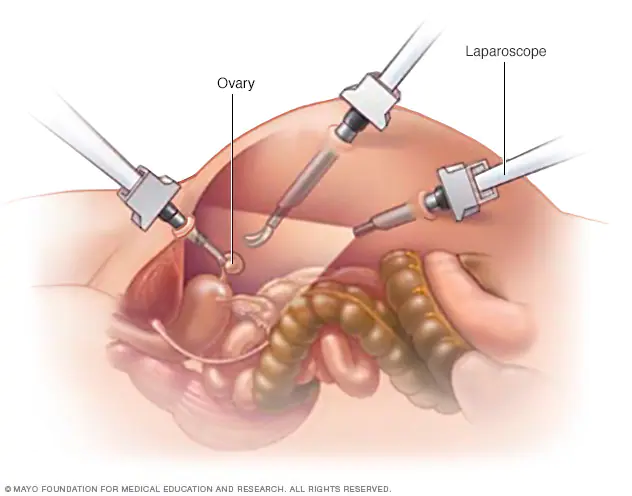Laparoscopic Salpingo-Oophorectomy (LSO) is a sophisticated surgical procedure employed to remove one or both ovaries and fallopian tubes through minimally invasive techniques. This procedure is often recommended for various medical conditions, including ovarian cysts, tumors, endometriosis, and certain types of cancer.

The laparoscopic approach involves making small incisions in the abdomen through which a thin, flexible tube called a laparoscope is inserted. This instrument contains a camera and surgical tools, allowing the surgeon to visualize the internal organs and perform precise maneuvers with enhanced accuracy. Carbon dioxide gas is then pumped into the abdomen to create space and improve visibility.
Before the surgery, patients typically undergo a thorough evaluation, including medical history assessment, physical examination, and diagnostic tests such as ultrasound, MRI, or CT scans. These investigations help the medical team determine the size, location, and nature of the ovarian or fallopian tube pathology and plan the appropriate surgical approach.
LSO can be performed under general anesthesia, ensuring that patients remain unconscious and pain-free throughout the procedure. Once the anesthesia takes effect, the surgeon makes a few small incisions, usually less than an inch in length, near the navel and lower abdomen. The laparoscope and other specialized instruments are then inserted through these incisions.
Using the laparoscope's high-definition camera, the surgeon navigates through the abdominal cavity, carefully inspecting the ovaries, fallopian tubes, and surrounding structures for abnormalities. If a cyst, tumor, or other pathology is identified, precise surgical techniques are employed to excise the affected tissue while preserving as much healthy tissue as possible.
One of the key advantages of LSO is its minimally invasive nature, which results in smaller incisions, reduced blood loss, and faster recovery times compared to traditional open surgery. Additionally, the risk of postoperative complications such as infection, blood clots, and wound healing problems is significantly lower with laparoscopic techniques.
During the procedure, the surgeon may also perform additional steps as needed, such as removing adhesions (scar tissue) or taking tissue samples for biopsy to further evaluate any suspicious lesions. These adjunctive procedures are aimed at optimizing the patient's outcomes and ensuring comprehensive management of their condition.
After the affected ovaries and fallopian tubes have been successfully removed, the surgical incisions are closed with sutures or surgical adhesive, and a sterile dressing may be applied. Patients are then transferred to a recovery area, where they are closely monitored as they wake up from anesthesia.
Most patients undergoing LSO can expect to go home the same day or after a short hospital stay, depending on their individual recovery progress and the complexity of the surgery. While some discomfort, bruising, and bloating are common in the days following the procedure, these symptoms can typically be managed with pain medication and rest.
In the weeks following LSO, patients are advised to gradually resume normal activities while avoiding heavy lifting and strenuous exercise. Follow-up appointments with the surgical team are scheduled to monitor the patient's progress, address any concerns, and discuss long-term management strategies, such as hormone replacement therapy if both ovaries were removed.
Overall, laparoscopic Salpingo-Oophorectomy offers a safe, effective, and minimally invasive approach to treating various gynecological conditions involving the ovaries and fallopian tubes. By combining advanced surgical techniques with state-of-the-art technology, this procedure enables patients to achieve optimal outcomes with minimal discomfort and downtime.
